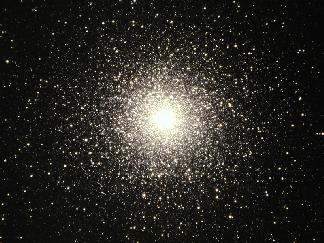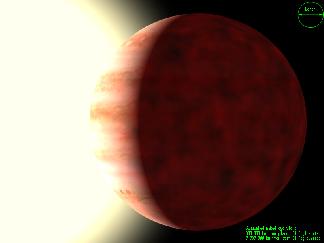Pegasus
M15 - Globular Cluster
51 Pegasai - Star with Planet
Pegasus is at its highest in the sky during September, October and November and its square, the body of the winged horse, is very well known. A very good test of sky transparency is to count the number of stars that you can see with your unaided eye within the square. If you count four, then the transparency is reasonably good, but if you can see more than four, then it will be an excellent night for hunting down faint galaxies and nebula! Pegasus is away from the plane of the Milky Way so is not rich in deep-sky objects but there are two A-List objects within its boundaries.
M15 - Globular Cluster B M
M15 is one of the six globular clusters brighter than 7th magnitude in the northern sky. It lies some 30,000 light years away beyond the thick dust lanes and star clouds in Sagittarius. M15 is easily found by following the line of the two stars Theta and Epsilon Pegasi a further 4 degrees in a north-westerly direction. So, by placing Epsilon at the appropriate side of a binocular or finder scope field, M15 should be visible towards the other. With medium power, the cluster is seen to lie within a triangle of three stars, one seventh and two 8th magnitude. M15 lies at a distance of 37,000 light years. Visually it appears to have an angular extent of about 7 arc minutes and has a very bright and compact core. Its overall brightness of magnitude 6.2 means that, under ideal viewing conditions, it could be seen with the unaided eye. Its brightest individual stars are 12 to 13th magnitude, so may be picked out individually against the glow of the fainter stars in the cluster when observing with a large aperture telescope. A recent Hubble Space Telescope image shows that stars in the dense core of M15 are crowded together closer than anywhere else in our galaxy, except at its very heart. At least 30,000 stars pack into a volume just 22 light years across. This could be the result of a process called 'core collapse' or perhaps a massive black hole is hidden at its centre!
Position 21h 30.0m +12deg 10min
51 Pegasi - Star with Planet B
Perhaps this is an odd choice for the A-List. There is nothing to see except a single 5.49 magnitude star that can be found just to the west (about 2 degrees) of the line joining the two stars at the western side of the square, Alpha and Beta Pegasi. It is a little nearer to Alpha. So why is it included? Simply because it has a place in history - the first Sun-like star around which a planet was detected. The planet, called 51 Pegasi b, has a mass of at least 0.47 times that of Jupiter. It orbits 51 Peg every 4.23 days; compare that with the 88 days that it takes Mercury to orbit the Sun! Its circular orbit has a radius of only 0.05 AU, just 7.5 million kilometres (4.6 million miles). So close to its star, its atmosphere would be extremely hot, perhaps 1000 degrees Celsius, and it would suffer extreme tidal forces. No one expected that a giant planet could exist so close to its sun – giving theoreticians much food for thought.
So how was it discovered? The light reflected by it would be lost in the glare of its sun so it cannot be seen. However, both the planet and star orbit their common centre of gravity so 51 Peg is moving round in a small circle. This means that sometimes it is coming towards us and sometimes away from us giving a very small shift in its spectral lines due to the Doppler shift. It was this that was detected in the spectrum of 51 Peg so allowing the period and minimum mass of its planetary companion to be calculated. Since then, many other planets have been detected by this method, but 51 Pegasi b will always have the distinction of being the first!
Position: 22h 57.6m +20deg 46min





